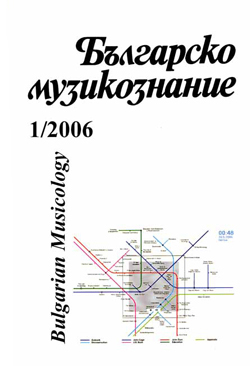Втората половина на XX век и методите за аналитично музикалнослухово възпитание. Слухова рефлексия върху посттоналната музика - Майкъл...
The Second Half of the 20th century and Methods for Analytic Musical Aural Education. Aural Reflection on Posttonal Music - Michael Friedman...
Author(s): Angelina PetrovaSubject(s): Music
Published by: Институт за изследване на изкуствата, Българска академия на науките
Summary/Abstract: The Second Half of the 20th century and Methods for Analytic Musical Aural Education. Aural Reflection on Posttonal Music - Michael Friedman. (Analytic Attempt at Solfeggio on Modal, Twelve-tone and Neo-tone Structures) In the second half of the 20th century aural experience is most radically changed. Aural perception - concerning the 20th century music and hence the principles of forming its methodology of the aural is put in isolation, and is rendered the most “fuzzy” field. At the end of the 90s, in an attempts to overcome this situation, a new type of analytical aural methods of solfeggio emerges. At the end of the 70s, Forte publishes “The Structure of Atonal Music” and manages to connect two at first glance controversial levels - the aural perceptive level and linguistically formal level. He also analyzes the pitch, tempo and motive components of the language. All this work established a portal, a basis at which syntactic structures of post-tonal experience might be realized in the field of solfeggio. Forte penetrates to the single “phoneme” in the organization of tunes and verticals, turns the “heights” and the “intervals” into subjects of formal research. Another important principle connecting Forte’s theory of perception (emerging from the traditions of Schenker) is the articulation of relations of “equality - similarity - difference” of pitch, linear and temporal structures, or best known as reduction. Generally, the theoretical conception of Forte is penetrated by several major criteria for musical perception, namely: 1. The principle of non-replacability of pitch values (which for the first time articulates the “lack of tone core”) 2. Education and study of invariant structures in dual connections of interval and pitch index 3. Chromatic complementation. Transforming the principle of reduction into an active element of musical perception and musical memory contains the focus of Freedman’s attempt to translate the linguistic level of “The structure of Atonal Music” by Forte into solfeggio practice. In this attempt the author conceptualizes the relations between the interval and pitch classes in order to obtain an analytical ear. Chasing one of the “visions craved” of the 20th century - spontaneous and even analytical aural realization of post-tonal music, Friedman creates a method for achieving active aural apparatus of non-standard typology.
Journal: Българско музикознание
- Issue Year: 2006
- Issue No: 1
- Page Range: 81-97
- Page Count: 17
- Language: Bulgarian
- Content File-PDF

